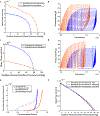Lymphatic remodelling in response to lymphatic injury in the hind limbs of sheep
- PMID: 31873209
- PMCID: PMC7549051
- DOI: 10.1038/s41551-019-0493-1
Lymphatic remodelling in response to lymphatic injury in the hind limbs of sheep
Abstract
Contractile activity in the lymphatic vasculature is essential for maintaining fluid balance within organs and tissues. However, the mechanisms by which collecting lymphatics adapt to changes in fluid load and how these adaptations influence lymphatic contractile activity are unknown. Here we report a model of lymphatic injury based on the ligation of one of two parallel lymphatic vessels in the hind limb of sheep and the evaluation of structural and functional changes in the intact, remodelling lymphatic vessel over a 42-day period. We show that the remodelled lymphatic vessel displayed increasing intrinsic contractile frequency, force generation and vessel compliance, as well as decreasing flow-mediated contractile inhibition via the enzyme endothelial nitric oxide synthase. A computational model of a chain of lymphatic contractile segments incorporating these adaptations predicted increases in the flow-generation capacity of the remodelled vessel at the expense of normal mitochondrial function and elevated oxidative stress within the lymphatic muscle. Our findings may inform interventions for mitigating lymphatic muscle fatigue in patients with dysfunctional lymphatics.
Conflict of interest statement
Competing interests
The authors declare no competing interests.
Figures







Similar articles
-
Temperature-dependent modulation of regional lymphatic contraction frequency and flow.Am J Physiol Heart Circ Physiol. 2017 Nov 1;313(5):H879-H889. doi: 10.1152/ajpheart.00267.2017. Epub 2017 Aug 4. Am J Physiol Heart Circ Physiol. 2017. PMID: 28778912
-
Recanalization of the collecting lymphatics in rabbit hind leg.Microcirculation. 2006 Jul-Aug;13(5):365-76. doi: 10.1080/10739680600745810. Microcirculation. 2006. PMID: 16815822
-
The relationship between lymphangion chain length and maximum pressure generation established through in vivo imaging and computational modeling.Am J Physiol Heart Circ Physiol. 2017 Dec 1;313(6):H1249-H1260. doi: 10.1152/ajpheart.00003.2017. Epub 2017 Aug 4. Am J Physiol Heart Circ Physiol. 2017. PMID: 28778909 Free PMC article.
-
Mechanics of Lymphatic Pumping and Lymphatic Function.Cold Spring Harb Perspect Med. 2025 Mar 3;15(3):a041171. doi: 10.1101/cshperspect.a041171. Cold Spring Harb Perspect Med. 2025. PMID: 38692743 Review.
-
Lymphatic vessels of the eye - old questions - new insights.Ann Anat. 2019 Jan;221:1-16. doi: 10.1016/j.aanat.2018.08.004. Epub 2018 Sep 18. Ann Anat. 2019. PMID: 30240907 Review.
Cited by
-
Decreased lymphatic HIF-2α accentuates lymphatic remodeling in lymphedema.J Clin Invest. 2020 Oct 1;130(10):5562-5575. doi: 10.1172/JCI136164. J Clin Invest. 2020. PMID: 32673288 Free PMC article.
-
A 1D model characterizing the role of spatiotemporal contraction distributions on lymph transport.Sci Rep. 2023 Dec 1;13(1):21241. doi: 10.1038/s41598-023-48131-3. Sci Rep. 2023. PMID: 38040740 Free PMC article.
-
Ascites in Animals With Right Heart Failure: Correlation With Lymphatic Dysfunction.J Am Heart Assoc. 2023 Apr 4;12(7):e026984. doi: 10.1161/JAHA.122.026984. Epub 2023 Mar 28. J Am Heart Assoc. 2023. PMID: 36974748 Free PMC article.
-
Effects of Intermittent Pneumatic Compression on Lower Limb Lymphedema in Patients with Type 2 Diabetes Mellitus: A Pilot Randomized Controlled Trial.Medicina (Kaunas). 2021 Sep 25;57(10):1018. doi: 10.3390/medicina57101018. Medicina (Kaunas). 2021. PMID: 34684055 Free PMC article. Clinical Trial.
References
-
- Levick JR & Michel CC Microvascular fluid exchange and the revised Starling principle. Cardiovasc Res 87, 198–210 (2010). - PubMed
Publication types
MeSH terms
Grants and funding
LinkOut - more resources
Full Text Sources

